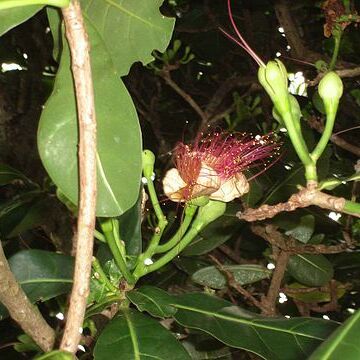Trees and shrubs. Leaves mostly tufted towards the ends of the branches, entire or slightly crenate-serrate; stipules very small, deciduous. Flowers mostly scented and often opening at night, in erect or pendulous, terminal or lateral racemes; bracts and bracteoles small, soon deciduous. Calyx-tube not or hardly produced above the ovary; limb of 3–5 free lobes or entirely closed before anthesis, then 2–5-lobed or circumscissile, persistent. Petals 4, rarely 5–6, adhering to the staminal tube at the base. Stamens connate into a short tube at the base; inner ones shorter, without anthers. Ovary 2–4(–5)-locular; ovules 2–many in each locule, mostly pendulous from the apex of the inner angle. Fruit with fleshy-fibrous exocarp and a woody-fibrous endocarp, indehiscent, usually 1-seeded by abortion. Seeds spindle-shaped or trigonous. Embryo undifferentiated, without cotyledons; no albumen.
Trees or shrubs, evergreen, deciduous or semi-deciduous. Leaves entire or serrate-crenate. Racemes usually long, terminal or axillary, or spikes long, cauliflorous; bracts small, sessile, caducous; receptacle obconical, 4-angled or 4-winged, glabrous. Calyx of 4 or 5 persistent imbricate lobes inserted on rim of receptacle, or breaking at anthesis into 2–5 persistent pseudo-lobes, or circumscissile leaving a cup-shaped rim. Petals 4, sometimes 3 or 5, free. Stamens many in 3–8 whorls, shortly connate, the innermost 1–3 whorls shorter and sterile; tube partly adnate to petals. Disc thin or thick, undulating; ovary 2–4-locular; ovules 2–6 per locule; style exceeding stamens. Fruit obovoid, ellipsoidal or fusiform, sometimes angled or winged, fleshy-fibrous. Seed 1, large; embryo fusiform, with spiral scales towards apex; cotyledons none.
Trees or shrubs. Stipules small, caducous. Leaf blade entire or serrate-crenate at margin. Inflorescences terminal or lateral, erect or pendulous racemes or spikes; bracts and bracteoles sessile, small, caducous. Receptacle obconic, 4-angled or 4-winged. Calyx of 4 or 5 persistent, imbricate lobes inserted on rim of receptacle, or breaking at anthesis into 2-5 persistent pseudo-lobes, or circumscissile leaving a cup-shaped rim. Petals (3 or)4(or 6), basally adhering to staminal tube. Stamens many in 3-8 whorls, shortly connate, innermost 1-3 whorls shorter and sterile. Ovary 2-4-loculed; ovules 2-8 per locule; style exceeding stamens. Fruit sometimes angled or winged, with fleshy-fibrous exocarp and woody-fibrous endocarp. Seed 1, large; embryo fusiform, with spiral scales toward apex; cotyledons absent, hypocotyl erect, thick.
Stamens numerous, multiseriate, with the filiform filaments of each whorl connate at the base into a short ring; anthers small.
Ovary 2–4-locular; ovules 2–8 in each locule, horizontal, pendulous, 2-seriate.
Petals 4, free from each other but somewhat adnate to the staminal ring.
Style filiform, very long, usually contorted; stigma small, simple.
Flowers in long terminal or lateral racemes or spikes.
Evergreen trees usually tall, more rarely shrubs.
Drupe fibrous, usually 1-seeded; embryo entire.
Calyx ± 4-lobate or 2–4 irregularly laciniate.
Disk intrastaminal.

